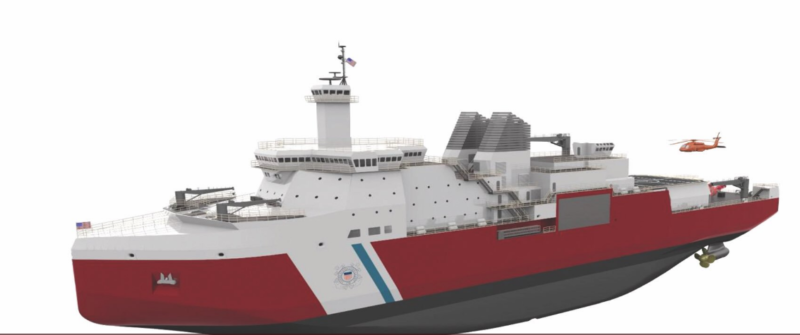On April 23, the Coast Guard and Navy announced it had awarded VT Halter Marine Inc. a $746 million contract for the design and construction of the Coast Guard’s lead 460'x88' polar security cutter (PSC).
To build the PSC, VT Halter plans to add 900 skilled workers and staff to the Pascagoula, Miss., shipyard.
The initial contract is for engineering and detail design of the PSC class as well as procurement of long lead-time materials and construction of the first ship. The full program could be worth $1.9 billion with the exercise of options to build two additional PSCs, replacements for the 399’x83’6”x31’ Polar Star, the last of two heavy icebreakers built in the mid-1970s. The first ship delivery is scheduled for 2024, the second in 2025, and the third and last PSC delivery has an estimated delivery date of early 2027.
The shipyard is teamed with Technology Associates Inc. (TAI) as ship designers, ABB/Trident Marine for its azipod propulsion system, Raymarine for command and control systems integration, Jamestown Metal Marine for the joiner package, and Bronswerk for the HVAC system.
For over two years, New Orleans-based TAI has participated in the Coast Guard’s Heavy Polar Icebreaker Industry Study. The ship design is an evolution from the mature current Polar Stern II design and construction. During the study, TAI incrementally adjusted the design and conducted a series of five ship model tank tests to optimize the design.
Caterpillar's diesel-electric package will contain the vessel's main engines, producing over 45,200 hp. The PSC will be capable of breaking ice 6' to 8' thick. The new cutter will be able to accommodate 186 personnel comfortably for an extended endurance of 90 days.
The Coast Guard’s long drive to recapitalize its icebreaking capability took a major step forward with the award of the contract.
The PSCs will support a wide range of Coast Guard missions including search and rescue, maritime law enforcement, environmental response, and national defense missions. VT Halter reportedly beat out two other bidders for the contract — Bollinger Shipyards and a partnership between Philly Shipyard and Fincantieri Marinette Marine.
The Coast Guard is the nation’s lead agency responsible for providing assured surface access in the polar regions. This contract award supports the United States’ ability to recapitalize heavy polar icebreaker capabilities that are vital to our nation’s ability to conduct national missions, respond to critical events, and project presence in the polar regions.

The Coast Guard Cutter Polar Star cuts through Antarctic ice in the Ross Sea near a large group of seals as the ship’s crew creates a navigation channel for supply ships, Jan. 16, 2017.
The resupply channel is an essential part of the yearly delivery of essential supplies to the National Science Foundation’s McMurdo Station. U.S. Coast Guard photo by Chief Petty Officer David Mosley.
In the fiscal year 2019 budget, Congress appropriated $655 million to begin construction of a new polar security cutter this year, with another $20 million appropriated for long-lead-time materials to build a second.
“Against the backdrop of great power competition, the polar security cutter is key to our nation’s presence in the polar regions,” said Admiral Karl L. Schultz, commandant of the Coast Guard. “With the strong support of both the Trump administration and the United States Congress, this contract award marks an important step towards building the nation's full complement of six polar icebreakers to meet the unique mission demands that have emerged from increased commerce, tourism, research, and international activities in the Arctic and Antarctic."
The acquisition of PSCs is being jointly managed by the Navy and Coast Guard through an Integrated Program Office (IPO) that leverages the expertise and utilizes best practices across each enterprise to deliver a fleet of highly capable, multimission ships in the most cost efficient and timely manner possible. NAVSEA is the lead contracting authority.
Caterpillar diesel electric package will contain the vessel's main engines, producing over 45,200 hp and the PSC will be capable of breaking ice 6' to 8' thick. The new cutter will be able to accommodate 188 personnel comfortably for an extended endurance of 90 days.
"This contract award reflects the great benefit achieved by integrating the incredible talents of U.S. Coast Guard and Navy acquisition and shipbuilding professionals to deliver best value at speed," said James Geurts, assistant secretary of the Navy for Research, Development and Acquisition. "Working with our industry partners, the team identified approximately $300 million in cost avoidances and accelerated the schedule for delivery of this capability to the nation by almost three years. This reflects the urgency in which we are operating to ensure we deliver capabilities necessary to support the U.S. Coast Guard and the nation’s missions in the polar regions."
Construction on the first PSC is planned to begin in 2021 with delivery planned for 2024, the second for 2025 and the third for 2027. However, the contract includes financial incentives for earlier delivery. If all options are exercised, work will continue through November 2027.




